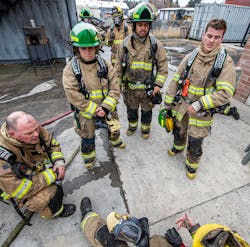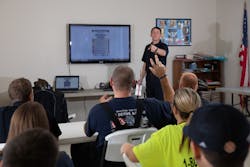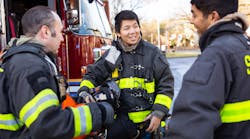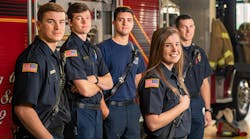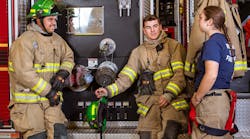This article is part of a larger supplement titled Recruiting and Retaining: The Future of Volunteer Fire Departments. View the supplement in its entirety here.
I am not that old. I grew up in the fire service. My dad started the local fire department in 1963 when I was a year old. Their first fire trucks were military surplus—deuce and a halfs, five tonners, jeeps. They held soup suppers to raise money. They knew nothing about fighting fire, but they did know that when a neighbor’s pasture caught on fire, it could end up burning down the barn, the pig shed or, worse, the house. Today, we’d call that the wildland-urban interface (WUI). They had never heard that term, but that’s why the fire department became a reality.
It was a community effort that was led by my father, my brother and their neighbors. At the beginning, they enlisted the help of the county seat fire department to do a little training on operation of the pumps on their trucks and a little bit about tactics. Over time, they acquired new, commercially built fire trucks. They bought SCBAs. They bought quick-response pickups with skid units. Now, there are new fire stations, new trucks, new gear—all of the things that we take for granted in many parts of the volunteer fire service.
The picture I want to paint
Back then, fire departments were created by groups of neighbors who banded together to help each other but who had little equipment and little money to operate. Today, we have a great complement of equipment and technology, but we struggle to fill the rosters.
What happened along the way? The community lost its school. Farms got bigger. Families became smaller. Both parents had to work. The result was a group of people that was no less committed to helping their neighbors, but smaller in number. Rural America still is filled with pastures and crops—that hasn’t changed—and the biggest percentage of fire call volume in many of these departments still is wildfires, just like before. We took on EMS in a lot of communities, too. Yet with fewer volunteers, the challenge is to make do with what we have. We use mutual aid more frequently. We use remote monitors. We take classes to learn to react smarter and take down the beast.
The reality has caused us to realize that we are more than just firefighters in our local community. We are firefighters whose neighborhood got a lot bigger. We learn from others. Our neighbors train with us, because we fight fire together. We network more frequently and seamlessly, using social media platforms, such as Facebook. Out of all of my friends on Facebook, I would estimate that more than three-fourths are firefighters. These firefighters post new ideas all of the time. They talk about how best to do an extrication with new metals in vehicles. They talk about a really cool new truck that their department bought. They talk about fighting cancer and how they are making efforts to reduce occupational risks.
It’s important to listen to these other voices and ideas. Just because we always did it one way doesn’t mean there aren’t other options. Although it’s true that sometimes we do things the same old way, because it works, other times, it’s simply because we don’t consider that there might be a better way to do it. Successful leaders understand that we need to grow, change and adapt to survive and to serve our neighbors in the best way possible. This is because we are a part of a bigger fire service world than ever before. Good leaders take the opportunity to let their firefighters learn and grow, even if it means that their firefighters have more knowledge than they have. This isn’t about who knows the most—it’s about doing and learning, so we can serve our neighbors.
All of this ultimately makes us more successful at recruiting and retaining volunteers. When we open our minds and take advantage of opportunities to connect with the broader fire service—whether through regional/state/national trainings, social media, professional forums or other networking opportunities—we learn about what has been successful (or not successful) with other departments. We become more connected to the greater community, which can deepen our sense of purpose and commitment to the fire service. We can keep up to date on the latest safety precautions, best practices and skills development techniques that can improve the working environment for our members. In other words, we build off of the shared knowledge and connections, to make our department a place where people want to be.
Turn words into action
What are things that you can start doing to think big? If your department is hosting a training, then invite your neighbors. You’ll be much more comfortable with their abilities when you see them train with your own folks. Most states offer some type of regional training, which often is sponsored by a state fire training agency or firefighters association. Make sure that those events are shared with the crew. It does no good if the chief is the only one who knows about a regional training.
Firefighters should make every effort to take in regional or statewide training opportunities at least once or twice a year. They’ll learn new things, and they’ll learn from firefighters from other departments. They have the same issues and the same incidents. At these trainings, participants will be amazed that, even though they went to take an extrication class, they wound up talking with other firefighters about what they do to encourage training as well as what they do to get new members and retain their existing ones. Will all of these ideas work in your department? Doubtful, but many of the ideas will work, can be modified or might inspire other ideas that you didn’t consider previously.
What is the alternative to broadening networks and expanding ideas? Continue to do what you’re doing and get the same results.
As a society, we are quick to moan and complain about what’s wrong, but firefighters are different. We don’t get to the scene of a fire, an accident, or an EMS call and just wring our hands. That isn’t how we are built. We jump in (following all proper scene and personal safety protocol), and we get the job done. Benjamin Franklin, who is responsible for this volunteer fire service, would be pleased with what he would see: A volunteer fire service that’s nimble enough to handle any incident that the world can throw at them, equipped as well as can be and trained beyond belief. Still, the basic principle remains from his time to ours, that we are called to help our neighbors and help them we will.
So, think big. Think about what you’re doing for your community. It isn’t small by any means. It’s huge. You are part of a big fire service, and you make the entire fire service community proud when you think big.
About the Author
Steve Hirsch is training officer for Sheridan County Rural Fire District #1, Thomas County Rural Fire District #4 and Grinnell Fire Department, all of which are 100 percent volunteer fire departments in Kansas. He also is the chair and Kansas director on the National Volunteer Fire Council (NVFC) and the first vice chair of the Kansas State Firefighters Association after serving as secretary from 2000-2018.
Steve Hirsch
Steve Hirsch is training officer for Sheridan County Rural Fire District # 1, Thomas County Rural Fire District #4 and Grinnell Fire Department, all of which are 100 percent volunteer fire departments in the state of Kansas. He also is the chair and Kansas director on the National Volunteer Fire Council (NVFC) and the first vice chair of the Kansas State Firefighters Association after serving as secretary from 2000–2018.
